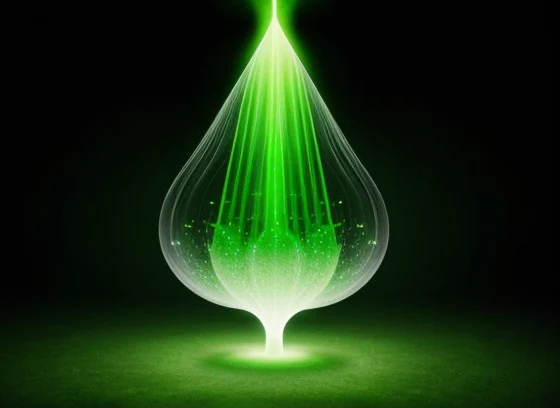Unveiling the Mysteries of Green Lightning: Nature’s Rare Phenomenon
For centuries green lightning, an elusive and serendipitous weather event has captured the fascination of scientists and sky watchers alike. Green lightning is an unusual form of atmospheric electrical phenomenon; it rarely occur and create a nice visual spectacle distinct from the more common white, blue or reddish-orange flashes. This strange phenomenon usually happens only in specific atmospheric conditions—most often, around volcanic eruptions or supercharged lightning storms thanks to localized upper-atmosphere chemical reactions. The phenomenon has been revered in folklore but not so well understood scientifically, and it was only recently that meteorologists were able to explain its magical appearance through studies involving atmospheric chemistry. By studying the roots, processes and outcomes of green lightning we may achieve a greater understanding about Earth’s meteorology as well as its broader environmental implications. While science expands on our understanding of this geological phenomenon, green lightning remains a reminder that the planet still hides plenty of its mysteries and there are enough conundrums to solve for mankind’s curiosity drive continuously.
What is Green Lightning?
A fire over the Atlantic also revealed green lightning, whose exact mechanism remains a mystery and has been studied for 290 years by both scientists and speculative writers. Green lightning, as opposed to white or blue or violet hues usually most associated with thunderstorms can manifest in a distinct greenish flavor. A variety of atmospheric conditions specific to each lightning event change the color given off by these gases/particles that are being excited. One theory is that the fiery riot was during volcanic activities and this increased green light, where sulphur gases may be interacting with lightning to give a new color. Despite many scientific experiments to expose the mystery of ‘green lightning’, it remains largely unknown with only a little documentation or witness sightings. This rarity, and difficulties in observing it first hand through contemporary research only wraps this natural fascination in more of an enigma to fuel further investigation.The title is a General Interest communication revolving around the activity due its revention.
Definition and explanation
Green lightning by Danny M 123 — a rare and captivating phenomenon is another unusual (and exceedingly infrequent) type of colored form that also stands out in the crowd as distinct blue or white discharge may well indeed pale to it’s inspiring green counterpart. Green lightning is environmentally based and generally only happens under rare circumstances of intense atmospheric conditions from volcanic eruptions or severe thunderstorms.
Green lightning has to do with sulfur, chlorine and volcanic ash which can come from the presence of a volcano. Green lightning: during thunderstorms, when the light coming from them scatter with atmospheric particles and gases in a way so that green wavelength is intensified. It is this scattering effect that makes the sky look blue during the day. The green color of the auroras, taken to a lesser extent by collisionally excitation in earthquake lightning and possibly other types of lightning indicates that there are some unusual states caused inside these erratic electrical phenomena.
Green lightning (to the extent that scientists know anything about it) may be a true ancillary curiosity, simply because of its rarity.
Historical observations
Very little is known about green lightning, and its rarity coupled with sparse historical accounts add to the enigma of this unique natural event. Unusual forms of lightning have even been referenced in certain ancient texts and folklore, with such spectacles being regarded as acts committed by the gods and nature. One thing humans did was to conclude that the flashes of coloured lightning in certain vivid, tropical thunderstorms were messages or omens from gods ( one story often quoted is found with some indiginous cultures) Sporadic reports of them have surfaced over the centuries in more scientific contexts. An early 20th-century account describes how pilots-dispatched to observe and document natural phenomena with more dedication-began noticing this.
During World War II, aviators reported seeing green lightning at high altitudes and thus began the science community’s interest in red sprites. Unfortunately, most of these historical anecdotes are based on rumor and speculation than scientifically documented findings. This paper shows that, even though green lighting is extremely rare and has only been observed for about 100 years, people clearly are well attuned to observing it — obviously thousands of years before scientific research in atmospheric science and electrical physics was available.
Common misconceptions
Green lightning is a wild and whimsical-sounding phenomenon, but it’s frequently the victim of misconceptions. Despite what might be expected, green lightning is not from an ideal perspective unique in relation to your common regular bolt of electricity. This confluence of atmospheric conditions, combined with certain particles in our atmosphere is what creates that green look. In some cases, the green color is incorrectly and very regrettably identified with supernatural or extraterrestrial events due to media representations and folklore.
Green lightning does not mean that the voltage of a discharge is higher, nor poses more risk. We know that the color difference has nothing to do with THE POWER OR WHATEVER of the lightning strike. In addition, green lightning is not a sign of dangerous or toxic atmosphere, but it may hint at the presence many small smog particles or peculiar light conditions. Realizing this sheds light on some of the mysteries surrounding green lightning and puts the public in line with scientific reasoning, making people more eager to explore and respect their natural occurrence.
Causes of Green Lightning
[Green lightning, a color seen in nature far less often than blue, purple or white flashes] is more of an exotic phenomenon both from [the standpoint of ] scientists and storm chasers. The main reason for green lightning to appear in the skies is due to electrical discharges mixing with specific atmospheric circumstances and components. Lightning is normally seen as a white or bluish arc in the sky — although it can take on many hues, everything from pink to orange striations color other parts of its People have even reported green lightning.
Some of the gases in our atmosphere have also a lot to do with this coloration. High temperatures, up to 30,000 Kelvin hot when lightning occurs in an atmosphere) ignite the gas along with it (a mix of oxygen and nitrogen), producing light emission within the blue to violet spectrum. If there are more of other elements, such as copper or chlorine (e.g. from volcanic ash, forest fires and industrial pollutants), then the discharge can actually excite those atoms causing them to emit green light instead.
Furthermore, the scattering of light by particles and droplets in water vapor‑ and dust-rich atmosphere can also lead to variations from the common blue/white color seen for most lightning. Put simply, the green light is created by certain chemical behaviours and environmental backgrounds that change those pristine lightning-bolt optics – giving us a tantalisingly fresh look at how complex nature truly can be.
Atmospheric conditions
Green lightning is a very rare, largely undocumented atmospheric phenomenon that was first reported as such in 1982.AgentBlue_HC (talk · contribs) ~~~~ This form of lightning is particularly common in severe thunderstorms that generate large hail and other heavy rainfall. This special tint of green is usually considered the signature mark for a presence of oxygen in an atmosphere. When lightning occurs, oxygen molecules are ionized and enter to the ground state emitting green light. Also, green lightning can often be seen in areas with a greater ozone content of the air or perhaps during volcanic eruptions when ash and gases change the atmospheric composition. The altitude and temperature conditions play a significant role in visibility, as well as the frequency of green lightning. Highly ionized, it most often occurs at higher elevations where there is less oxygen and lower temperatures that can effect the wave length of light produced during electrical discharges. And finally, unraveling the mysteries behind this beautiful natural phenomenon all comes down to understanding these atmospheric aspects of our planet.
Chemical reactions involved
Due to the rarity and occasional transient nature of this fascinating atmospheric event, most research on green lightning is approached from a chemical perspective explaining how reactions in thunderstorms are capable leading to scientifically elusive events. It is this greenish colour that results from particular ionization stages during the lightning discharge. A lightning bolt is a huge packet of energy surging down the atmosphere, ionizing nitrogen and oxygen molecules as it goes.
In this high-energy process, nitrogen molecules produce a range of light that gets quite green-heavy. An additional cause may be that the oxygen is ionized, and recaptures an electron to become neutral in which case it produces green light. The green lightning can also be sighted near the volcanic eruptions; when such an eruption occurs, micron scale particulates which contain copper etc. may enter into atmosphere resulting in green light phenomena happening with it as well. It is this green emission coming from the excitation of copper atoms that adds to its distinctive hue.
And though the exact methods remain somewhat speculative and are, no doubt still being worked out in laboratory simulations – these chemical reactions brilliantly demonstrate how such behavior ultimately defines green lightning; nature’s design of its own atmospheric processes to be complex… alluring.
Geographic locations prone to occurrences
Green lightning: it is an extremely rare form of luminous atmospheric optical phenomenon that happens in thunderstorms. Green lightning is more common in geographical locations of the world with active volcanic activity. So places like the Krakatoa in Indonesia, Sakurajima in Japan and Italy’s Stromboli have all at some stage reported scientists seeing their own lava domes. However in these parts of the world, there are regular eruptions that and send huge ash clouds up to launch green lightning.
The lightning forms from the unusual interaction of volcanic ash, particles and atmospheric conditions in these regions. What could be making this storm’s clouds green. numerous scientists have suggested that an electric-green coloration of gas like methane or minerals in Earth-like volcanic settings such as lightning may lie at the heart of it all Similarly, green bolts of lightning have been detected in the high-altitude regions near the poles where auroral activity occurs may be initiated by rates charged up and critically excited ions — causing them to emit a photon via field-enhanced emission – or molecules (by arc illumination). Though our knowledge remains lacking, the examination of these areas can help to unlock part of this otherwise enigmatic and wondrous phenomena.
Scientific Studies and Research
Green lightning, a rare weather phenomenon has been studied and researched scientifically to know more about why exists. More often, researchers report that green lightning is observed alongside volcanic eruptions where the gases and ash are consistent with its unique coloration. These flashes are so momentary that they have to be imaged using high-speed cameras combined with spectroscopic techniques.
A popular explanation is that green lightning might come when the atmosphere filters out other colors of light, leaving only a particular band to reach our eyes much as how blue sky occurs due to atmospheric particulate scattering. For example, one suggests that the green might involve ionized gases in Earth’s atmosphere—at a high enough voltage level oxygen and other gases could go from being clear to glowing with an eerie tint.
Scientists have used this approach to recreate field conditions and test their hypotheses in laboratory simulations. Ultimately deciphering how green lightning forms might not only help us better understand many other atmospheric processes, but also — in ways large or small — improve weather models and the like we all rely on to keep track of extreme conditions.
Key researchers and discoveries
Researchers have long sought a natural explanation for rare and intriguing green lightning. One figure to highlight in this realm was Dr. Walter Lyons, a meteorologist and expert in atmospheric optics. Lyons and his FMA Research team have researched various forms of lightning, including the still unknown green form. Previous work by some of the same researchers behind this new paper suggested that green lightning can only happen under specific atmospheric circumstances when there’s an excess of oxygen and a certain kind of aerosol in play.
Also a major contributor is Dr. Martin A. Uman of the University of Florida, one of the nations foremost lightning physicists Thankfully, as we conclude from Uman’s inquiries are that the basic mechanisms behind how lightning shapes and its assortment of hues function have another arising inquiry.
Moreover, advancements in satellite technology have allowed researchers to more comprehensively observe the elusive green lightning. These advances, the result of collaborations between institutions such as NASA and the European Space Agency are key for expanding our knowledge of this striking but complex natural phenomenon.
Technological advancements in detection
Green lighting is a rare and ill-understood phenomenon, but the recent technological advances in detection have improved our knowledge of it. The modern satellite with advanced sensors, and high-resolution imaging capabilities provide a space eye to monitor them live from the sky. These networks also work with a variety of ground-based lightning detection and reporting systems (using both radio, optical and infrared sensors), provide additional information that supplement the satellite data.
The use of high-speed cameras and spectrographs can even permit the observation in real-time at specific wavelengths during green lighting, giving researchers clues to what is causing it. Machine learning algorithms trained on a massive compendium of meteorological data to predict where green lightning might arise, and which environmental factors or storm types are the most likely seeding grounds. The suite of technological advances described collectively move towards demystifying this rare phenomenon, thus enriching our global understanding of the atmospheric electricity and its climatic proxy channel.
Challenges faced in studying green lightning
Green lighting is so rarely seen and occurs under such unusual circumstances that it will be difficult to study deeply. Green lightning, a very rare occurance which is usually related to volcanic eruptions or distinctive atmospheric surroundings stands out in differentiation of the usual white and bluish lightning. The scarcity and brevity of these events is a significant challenge to scientists, who may not be around at the time to view and record them. › This equates to a need for expensive specialized equipment, including high-speed cameras and spectrometers strategically located near active volcanoes or in hazardous conditions such as during thunderstorms. Green lightning is short lived, which means data collection and analysis require a level of precision that takes time to plan and coordinate. Additionally, untangling the specific atmospheric processes and chemistry that make the sky green compounds complexity into what should be an interdisciplinary venture among practitioners of meteorology, atmospheric chemistry and physics.
Impacts and Implications
Impacts and Implications
What is rarer still: green lightning remains a frontier of atmospheric research and carries clues to science much more consequential than alien possibilities. On a scientific level, studying green lightning could also expand our understanding of the dynamics behind how lightning functions — such as the ionization processes and other gases in the atmosphere. Such information could help improve models predicting lightning activity, which is key to better weather forecasts and even in reducing the danger of severe storm-related events.
Green lightning is terrible for the environment. For example, lightning-induced wildfires may irreversibly change habitats and biodiversity but those are rare with green lightning. Additionally, knowledge of the known conditions that favor green lightning may give us hints about atmospheric chemistry and what elements (e.g., atomic oxygen) are actually present in our upper atmosphere.
Green lightning as a whole provides an unprecedented view of natural forces that could yield new insights and prospects in meteorology, the earth sciences, etc. The research underscores the need for ongoing atmospheric exploration of our ever-changing Earth.
Environmental effects
Massive column of green lightning (extremely rare and beautiful) photographed near Madison, Wisconsin Green LightningGreen lightning is not only a very captivating phenomenon, but it also has important impacts on the environment that can provide significant insight to atmospheric sciences. The unusual lightning color is due to specific atmospheric conditions — and the presence of nitrogen, as California Institute of Technology planetary astronomer Michael Brown used excited oxygen molecules emit green light when ionized by high-energy electrical discharges. The appearance of green lightning is associated with strong thunderstorms and the severity weather events that could be clues about climatic patterns or environmental health.
A key environmental impact of green lightning is the formation of nitrogen oxides, some dangerous greenhouse gases and also play an important role in ground level ozone. Air quality and the stages of climate regulation are influenced by these chemical reactions. In addition, green lightning can pinpoint where high concentrations of convection are located (and is a feature characteristic to severe-weather-producing hotspots like hurricanes or tornadoes), making it an important observational tool. Knowing the environmental consequences could improve forecasts and warnings for perilous weather conditions.
Influence on weather patterns
Green spark — a rare, hypnotic weather phenomenon that even left many mail scientists baffled. We still need to understand the full extent of its impact on weather, an area where active research is being done. Most of the time a very unusual electrical discharge that only appears during volcanic eruptions and in rare cases depressions or holes above powerful thunderstorms takes place, often with large volumes of erupted pumice rock § Volcanic ash ejections into to extreme atmospheric conditions can produce strange cloud-to-cloud lightning.
Green lightning could be the result of specific particles that happen to exist in a particular part of our atmosphere or gas mixtures. One possibility, for instance, is that the green colour comes from ionized atmospheric oxygen: These ions can modify local electric charges and thereby influence how storms grow. This lightning means the atmosphere is very electrified and could lead to stronger or more erratic weather systems in that region.
The ability to identify green lightning and understand what it means will allow researchers create more accurate storm models, offering a better idea of the weather patterns most likely to generate these kinds of storms so that they can be met with appropriate levels disaster preparedness. Researchers hope that by studying this infrequent event, we can discover new things about atmospheric science and improve our understanding of how to predict these severe weather events in the future.
Significance for scientific understanding of lightning
Demystification of green lightning could have far-reaching repercussions on the scientific understanding concerning atmospheric phenomena and lightning. Green lightning can be much rarer and more exotic form of a common, but it may provide valuable clues as to what the Earth’s atmosphere is made of in some circumstances. The green color could mean there are atypical interactions happening between lightning and atmospheric molecules such as oxygen or nitrogen, which cannot be expressed through easily explained rules. By examining green lightning, researchers would be able to adjust models of atmospheric chemistry and physics, test forecasts for when lighting will occur–and find out more about how energy moves during a thunderstorm. This information is critical for improving aviation safety, safeguarding electrical infrastructure and acquiring a better understanding of Earth’s climatic and environmental systems. The knowledge of such rare phenomena could also point towards similar happenings on other planets, implying a general picture about the atmospheres across planet earths.
So what have we concluded?
In this respect the occurrence of green lighting, although remotely rare and mysterious in nature is a spectacular peephole into our atmosphere. The extraordinary phenomena is recognised by its vivid emerald colours and occurs under unusual atmospheric conditions, which are commonly involved in volcanic eruptions or severe thunderstorms. Understanding green lightning might help scientists figure out how electrical activity in the atmosphere links to atmospheric composition, weather and physics. In addition, studying such rarities further informs us on the various manifestations of meteorological events and highlights how intricate and marvelous nature can be. Related: As we work to understand green lightning more definitively, its worth remembering just how much is still untapped and making us want to ask question after question about the mysterious things our own planet has up all over it. In all, the discoveries underscore how atmospheric research can aid safety and preparedness while deepening our wonder of nature.





